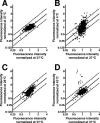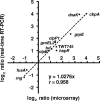Global transcriptome analysis of Tropheryma whipplei in response to temperature stresses
- PMID: 16816195
- PMCID: PMC1539978
- DOI: 10.1128/JB.00507-06
Global transcriptome analysis of Tropheryma whipplei in response to temperature stresses
Abstract
Tropheryma whipplei, the agent responsible for Whipple disease, is a poorly known pathogen suspected to have an environmental origin. The availability of the sequence of the 0.92-Mb genome of this organism made a global gene expression analysis in response to thermal stresses feasible, which resulted in unique transcription profiles. A few genes were differentially transcribed after 15 min of exposure at 43 degrees C. The effects observed included up-regulation of the dnaK regulon, which is composed of six genes and is likely to be under control of two HspR-associated inverted repeats (HAIR motifs) found in the 5' region. Putative virulence factors, like the RibC and IspDF proteins, were also overexpressed. While it was not affected much by heat shock, the T. whipplei transcriptome was strongly modified following cold shock at 4 degrees C. For the 149 genes that were differentially transcribed, eight regulons were identified, and one of them was composed of five genes exhibiting similarity with genes encoding ABC transporters. Up-regulation of these genes suggested that there was an increase in nutrient uptake when the bacterium was exposed to cold stress. As observed for other bacterial species, the major classes of differentially transcribed genes encode membrane proteins and enzymes involved in fatty acid biosynthesis, indicating that membrane modifications are critical. Paradoxically, the heat shock proteins GroEL2 and ClpP1 were up-regulated. Altogether, the data show that despite the lack of classical regulation pathways, T. whipplei exhibits an adaptive response to thermal stresses which is consistent with its specific environmental origin and could allow survival under cold conditions.
Figures






Similar articles
-
Examination of stress and virulence gene expression in Escherichia coli O157:H7 using targeted microarray analysis.Foodborne Pathog Dis. 2008 Aug;5(4):437-47. doi: 10.1089/fpd.2008.0100. Foodborne Pathog Dis. 2008. PMID: 18713062
-
Global transcriptome analysis of the cold shock response of Shewanella oneidensis MR-1 and mutational analysis of its classical cold shock proteins.J Bacteriol. 2006 Jun;188(12):4560-9. doi: 10.1128/JB.01908-05. J Bacteriol. 2006. PMID: 16740962 Free PMC article.
-
Global proteomic pattern of Tropheryma whipplei: a Whipple's disease bacterium.Proteomics. 2009 Mar;9(6):1593-616. doi: 10.1002/pmic.200700889. Proteomics. 2009. PMID: 19253299
-
D-Serine exposure resulted in gene expression changes indicative of activation of fibrogenic pathways and down-regulation of energy metabolism and oxidative stress response.Toxicology. 2008 Jan 14;243(1-2):177-92. doi: 10.1016/j.tox.2007.10.009. Epub 2007 Oct 23. Toxicology. 2008. PMID: 18061331
-
Global transcriptome analysis of the heat shock response of Bifidobacterium longum.FEMS Microbiol Lett. 2007 Jun;271(1):136-45. doi: 10.1111/j.1574-6968.2007.00704.x. Epub 2007 Apr 10. FEMS Microbiol Lett. 2007. PMID: 17419761
Cited by
-
Changing paradigms in Whipple's disease and infection with Tropheryma whipplei.Eur J Clin Microbiol Infect Dis. 2011 Oct;30(10):1151-8. doi: 10.1007/s10096-011-1209-y. Epub 2011 Apr 2. Eur J Clin Microbiol Infect Dis. 2011. PMID: 21461659 Review.
-
Global transcriptional response to heat shock of the legume symbiont Mesorhizobium loti MAFF303099 comprises extensive gene downregulation.DNA Res. 2014;21(2):195-206. doi: 10.1093/dnares/dst050. Epub 2013 Nov 25. DNA Res. 2014. PMID: 24277738 Free PMC article.
-
Genome-wide screen for temperature-regulated genes of the obligate intracellular bacterium, Rickettsia typhi.BMC Microbiol. 2008 Apr 15;8:61. doi: 10.1186/1471-2180-8-61. BMC Microbiol. 2008. PMID: 18412961 Free PMC article.
-
Coxiella burnetii transcriptional analysis reveals serendipity clusters of regulation in intracellular bacteria.PLoS One. 2010 Dec 21;5(12):e15321. doi: 10.1371/journal.pone.0015321. PLoS One. 2010. PMID: 21203564 Free PMC article.
-
Effects of Arsenic on Trichloroethene-Dechlorination Activities of Dehalococcoides mccartyi 195.Environ Sci Technol. 2020 Jan 21;54(2):1276-1285. doi: 10.1021/acs.est.9b06527. Epub 2020 Jan 8. Environ Sci Technol. 2020. PMID: 31913608 Free PMC article.
References
-
- Andersen, M. T., L. Brondsted, B. M. Pearson, F. Mulholland, M. Parker, C. Pin, J. M. Wells, and H. Ingmer. 2005. Diverse roles for HspR in Campylobacter jejuni revealed by the proteome, transcriptome and phenotypic characterization of an hspR mutant. Microbiology 151:905-915. - PubMed
-
- Apirion, D., J. Neil, and N. Watson. 1976. Consequences of losing ribonuclease III on the Escherichia coli cell. Mol. Gen. Genet. 144:185-190. - PubMed
Publication types
MeSH terms
Substances
LinkOut - more resources
Full Text Sources
Molecular Biology Databases
Research Materials
Miscellaneous

